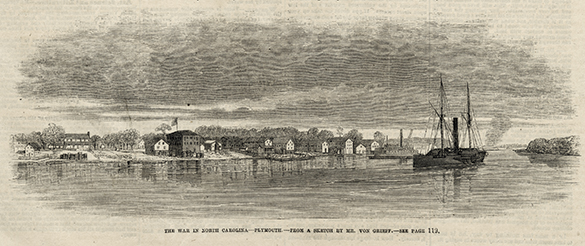Item description: “The War in North Carolina—Plymouth.—From a sketch by Mr. Von Grieff.” In Frank Leslie’s Illustrated Newspaper, 14 May 1864, page 116. The illustration accompanied the article “Plymouth, North Carolina” on page 119.
Note: The article and illustration depict events that transpired on 19 April 1864. Another illustration from the event printed a week earlier in Harper’s Weekly can be seen at http://library.unc.edu/wilson/ncc/pcoll/civilwar/index.html?list=Naval_Operations.
Transcription of article accompanying illustration (page 119):
PLYMOUTH, NORTH CAROLINA.
It is not an attractive subject, but we give our readers a view of Plymouth, N. C. made by an officer during a stay of more than a year at that post, which has now been, in a manner so disgraceful to our arms, wrested from us.
Plymouth is eight miles south of Roanoke river, and is connected with Albemarle sound by a small inlet called Nag’s Head. It had, in other days, a population of about 1,000, and was rapidly increasing in trade.
The Loss of Southfield.
Nothing can be more disheartening than the disasters at Plymouth. The Navy Department had long been aware that the rebels were building a formidable ram on the Roanoke. When at last Plymouth was menaced by an immense force on land and the rain was known to be descending the river, the Bombshell, an old Erie canal boat, was sent to meet her. A rebel land battery, by sinking her, saved her from being run down by the ram Albemarle. The latter came down stealthily under the shadow of the bank and ran into the Southfield, a Staten Island ferryboat, sinking it in ten minutes after her formidable serrated prow crushed through its sides.
The Miami, Capt. Flusser, lay alongside, and the commander who had been actively shelling the rebels ashore, sighted and fired a gun at the Albemarle, but it rebounded in fragments from the sloping side, killing Flusser himself.
Captain Flusser is a loss to the service, for he was an active, energetic officer, and had prepared with his scanty means to do all that he could in the emergency. It was his intention to connect two boats firmly together, by means of chains and spars, and seek the encounter by advancing against the ram, aiming to strike her between both vessels and force her against the shore. At the same time a torpedo was to be so arranged as to cast it into her smoke stack, but owing to circumstances beyond his control, the arrangements were not executed. After his fall several steel-pointed shot were fired at the ram, but all failed to pierce her well armored sides.
Citation:North Carolina County Photographic Collection (P0001), P0001, Flat Box 10, Folder P0001/1521. North Carolina Collection, Wilson Library, University of North Carolina at Chapel Hill.


